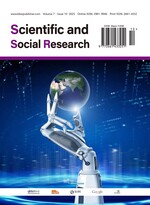Research on Value Evaluation and Protective Development Strategies for Chongqing’s Port- Opening Heritage Park
Abstract
This study focuses on Chongqing’s Port-Opening Heritage Park, employing a combination of the Analytic Hierarchy Process (AHP) and Fuzzy Comprehensive Evaluation Method. Through expert interviews and the quantitative analysis of 492 valid questionnaire responses, the park’s comprehensive value was assessed. The findings indicate that the park’s comprehensive value score is 3.205 out of 5, placing it at an above-average level. Among the evaluated aspects, social value performed the best, while historical and cultural values were balanced. However, there is room for improvement in ecological and scientific values. Based on the evaluation results, this paper proposes protective development strategies, including deepening cultural experiences and educational functions, innovating historical narratives and intangible cultural heritage revitalization, developing low-impact and high-value-added business formats, strengthening ecological interpretation and scientific planning, and fostering value consensus through targeted communication and dynamic feedback mechanisms. This research provides theoretical and practical foundations for the sustainable development of heritage parks and offers insights for the protection and development of similar cultural heritage sites.
References
Ministry of Housing and Urban-Rural Development, 2017, Standard for Classification of Urban Green Space: CJJ/T 85—2017. China Architecture & Building Press, Beijing.
Shan JX, 2010, Exploration and Practice of Large-Scale Archaeological Site Parks. Chinese Cultural Heritage Research, 2010(1): 2–12.
Li AM, 2010, The Advantages of Archaeological Site Parks in the Protection of Major Archaeological Sites in China. Social Scientist, 2010(9): 96–98.
Zhu XW, 2011, Research on Urban Cultural Ecosystem Based on Archaeological Site Parks: A Case Study of Xi’an. Human Geography, 26(2): 112–115 + 36.
Que WM, 2015, The Nomenclature Paradox of “Archaeological Site Parks”: A Case Study of the “Yuanmingyuan Ruins Park”. Chinese Cultural Heritage, 2015(5): 56–61.
Humphrey Welfare, Zhang YM, Yu B, 2018, Conservation and Strategic Management of Hadrian’s Wall. Chinese Cultural Heritage, 2018(3): 71–77.
Capozzi R, Picone A, Visconti F, 2016, Archaeology, Architecture and City: The Enhancement Project of the Archaeological Park of the Baths of Baiae. ArchNet-IJAR: International Journal of Architectural Research, 10(1): 113–130.
Mauro A, Brunetti B, Cattazzo S, et al., 2025, Condition Survey of Tavole Palatine and Metaponto Archaeological Site Park. Springer Proceedings in Materials, 2025(70): 94–108. https://doi.org/10.1007/978-3-031-87068-2_7
Wu X, Cui P, 2016, Analysis of Place Attachment Characteristics in Historical Site Parks: A Case Study of Xi’an Qujiangchi Relics Park. Journal of Northwest University (Natural Science Edition), 46(4): 606–610.
Zhang JZ, Sun GN, 2012, Heritage Parks: A New Form of Cultural Heritage Experience Tourism Development—A Case Study of Three Major Heritage Parks in Xi’an. Human Geography, 27(1): 142–146.
Huang CY, He JX, Tuo BF, et al., 2023, Research on Viewing Space Optimization Based on Dynamic and Static Visual Landscape Evaluation: A Case Study of Yangjiacheng Heritage Park in Shenmu City. Planners, 39(4): 93–100.
Tao L, Zhao YC, 2020, Research on the Tourism Development Path of National Archaeological Heritage Parks Based on Typological Characteristics. Journal of Yunnan Minzu University (Philosophy and Social Sciences Edition), 37(3): 75–80.
Dai JC, 2023, Path Analysis of Research on National Cultural Parks. Tourism Tribune, 38(6): 40–51.
Romeril M, Fuller RA, 1985, Tourism and Heritage in the United Kingdom. The Environmentalist, 5(4): 306–309.
Gerlach J, Kinossian N, 2016, Cultural Landscape of the Arctic: “Recycling” of Soviet Imagery in the Russian Settlement of Barentsburg, Svalbard (Norway). Polar Geography, 39(1): 1–19.
Szromek AR, Krzysztof H, Mateusz N, 2021, Sustainable Development of Industrial Heritage Tourism: A Case Study of the Industrial Monuments Route in Poland. Tourism Management, 2021(83): 104252.
Bayramova V, Kryukovskiy A, Kupriianova A, et al., 2021, Modern Challenges in the Comprehensive Assessment of the Recreational Potential of Historical Parks. IOP Conference Series: Earth and Environmental Science, 876(1): 012011.
Korunovski S, Marinoski N, 2012, Cultural Tourism in Ohrid as a Selective Form of Tourism Development. Procedia — Social and Behavioral Sciences, 2012(44): 104–113.
Galicz IV, Magda R, David LD, 2024, Archaeological Parks in the Service of Tourism: A Comparative Analysis of Hungarian and Western European Archaeological Parks. Sustainability, 16(8): 3313.
Amin S, Pramono SE, Kurniawan GF, 2021, Historical Park Development for Inclusive Tourism in Semarang. IOP Conference Series: Earth and Environmental Science, 747(1): 012043.
Vahtar-Jurkovic K, Sokol Jurkovic R, Jurkovic J, 2024, The Park Heritage of the Island of Krk amidst Urban Transformations and Climate Change. Land, 13(7): 1024.
Xi YT, Luo S, Han YR, 2024, Visual Analysis of Research Literature on National Archaeological Site Parks. Journal of Xi’an University of Finance and Economics, 37(3): 118–128.
Guo JY, Zhang ZB, Sun QY, 2008, Research and Application of the Analytic Hierarchy Process. China Safety Science Journal, 2008(5): 148–153.
Deng X, Li JM, Zeng HJ, et al., 2012, Analysis of Weight Calculation Methods in Analytic Hierarchy Process and Its Application Research. Mathematics in Practice and Theory, 42(7): 93–100.
Amin S, Pramono SE, Kurniawan GF, 2021, Historical Park of Inclusive Tourism Development in Semarang. IOP Conference Series: Earth and Environmental Science, 2021.
Bayramova V, Kryukovskiy A, Kupriianova A, et al., 2021, Modern Problems of Comprehensive Assessment of Recreational Potential in Historical Parks. IOP Conference Series: Earth and Environmental Science, 2021.
Mei Q, Bai CY, Sun SR, et al., 2007, Empirical Research on Protective Tourism Development in Historical Districts. Commercial Research, 2007(1): 167–169.
Wang XL, Ma XN, Yuan N, et al., 2012, Research on Tourism Resource Evaluation and Protective Development Based on AHP Method: A Case Study of Wudang Mountain World Heritage Site. Resource Development & Market, 28(10): 938–940 + 867.
Jiang XB, Liu S, Lai QH, 2010, Research on Protective Development of Ethnic Village Tourism: A Case Study of Yishala Village in Panzhihua. China Business & Trade, 2010(18): 82–83.
Chen WJ, Chen HL, Fang YY, 2007, Inheritance and Protective Development of Characteristic Ancient Residential Culture. Commercial Times, 2007(36): 97–98 + 62.
Wang XW, Liu S, 2023, Research on the Value Evaluation Method of Large Sites from the Perspective of Archaeological Site Parks: A Concurrent Discussion on the Value Evaluation of Tongwancheng Site. Southeast Culture, 2023(1): 13–23.

